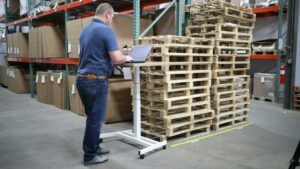Productivity, Warehousing • 9 Minute Read • Jul 1, 2024
Ecommerce Warehouse Basics for Beginners

You’ve got the idea, the website, the materials to make the product, and the know-how to conduct the service. Now, you need a warehouse. Yet, this may be an intimidating task or step given everything that goes into setting up a warehouse. Your backend operations and warehouse management system require planning, implementation, and adjustments over time.
Even picking the right space is a big decision. And, if your business is new, you may be eyeing your garage or basement as a warehouse option.
Before you start clearing out bikes or Christmas decorations, learn about the warehouse basics.
What is an ecommerce warehouse?
An ecommerce warehouse is a central location for storing and managing physical goods before they’re sold. It’s a space to safely and securely store products. In warehouses, receiving, processing, and delivering takes place. Business owners can keep their products in stock and track the quantity in real time – including in the warehouse or en route to the customer.
A warehouse can help you provide customers with an exceptional experience if done well. An unorganized or cluttered warehouse not only negatively impacts customer experience, it can also be dangerous and expensive for business owners.
Building a strong warehouse foundation (or learning practices considered to be warehouse basics) can help you improve or maintain the efficiency of your operations. Implementing warehouse basic practices reduce space requirements, save on time and labor costs, and reduce errors.

How do I start at ecommerce warehouse?
Starting an ecommerce warehouse begins with determining your needs. Take a couple of notes on the following questions:
- How much space does your warehouse need? Consider the number of pallets or cartons you’ll need.
- What type of warehouse management systems or software do you plan to use?
- Could a central distribution location help reduce shipping times?
- How do you expect your business will scale? Will your warehouse plan accommodate growth?
Starting your warehouse in your home may make sense at first. You can keep an eye on your stock levels easily, pack and ship orders when it is convenient, and pick up your new inventory at the front door in your slippers.
But, you may grow out of your guest bedroom faster than you expect.

Warehouse Basics: Type of Warehouse
Warehouse basics 101: You have to pick the right type of warehouse for your operations. There are many different types of warehouses because no space is perfect for every business. Ideally, you’ll have space for all of the following no matter which warehouse option you pick:
- Product storage
- Forward staging
- Shipping quality control
- Pallet break down areas
- Return or “dead” stock area
Picking the right place usually depends on the amount of space you need, your budget, the location compared to your customers, the location compared to where you reside, and the compatibility with your products.
Below are some of your options.
A Home Warehouse Space
Your garage, shed, guest bedroom, or basement may be a suitable space while you’re getting your business off the ground. It’s convenient to have all your products within walking distance and is likely your most affordable option. Yet, there is a good chance you will outgrow this option quickly.
Plus, if your warehouse is your home, there’s not much you can do if your cat has a litter of kittens in one of your product boxes – a far less likely scenario in a warehouse.
Renting a Pod or Storage Unit
Renting a pod or storage space can be a cost effective way to scale your business once you’ve outgrown your home. You’ll have some control over the space but not full autonomy as a renter.
Another downside is pods and storage units can have more laxed or non-existent security. If you’re worried about keeping your products safe, a pod may not be the best place to set up a warehouse.
Co-Warehousing Space
Any warehousing space is designed to store lots of products – unlike garages and basements which still have some kind of livability ascribed to their design.
Co-warehousing provides ecommerce business owners with a more affordable and secure warehousing option. Most co-warehousing spaces have many floor plan options, helping you meet your current budgetary constraints but also providing expansion opportunities without moving your entire warehouse.
Co-warehousing spaces can also offer a community aspect. You will be working side-by-side with other entrepreneurs who you use as a resource if you have questions or want to talk through ideas. You could also potentially reduce costs by ordering items multiple businesses in the co-warehousing space need in bulk, or shipping packages together.
Buying or Renting Your Own Warehousing Space
Buying a warehouse gives you full control over your space and products. Yet, most small business owners don’t have the cash laying around to invest in real estate, which is why many ecommerce owners rent their warehouse space.
Renting your own warehouse is a more affordable option compared to buying a warehouse, but is more expensive (in most cases) than co-warehousing. Your lease may come with many limitations that could make it difficult to scale.
 Warehouse Basics: Management
Warehouse Basics: Management
Once you’ve picked the perfect space for a warehouse, the next step is set up. Warehouses include storage, technologies, systems, equipment, and infrastructure. Each plays an important role in managing your products and getting items shipped to customers. The more efficient your logistics, the more timely your deliveries.
Create an Effective Inventory System
If your inventory is a mess it can bring your business to a halt. Make sure you have a way to track your stock levels and movement of goods, recording inbound and outbound shipments. You’ll want to make sure each item is properly labeled, and establish a process for ordering new stock and monitoring your inventory levels.
Optimize Your Layout
A great layout will make your life easier, save you time, and keep your business running smoothly. When creating a layout, remember to maximize the vertical space. Set up strategic picking paths, so the items sold frequently are easy to reach and closer to shipping.
Store less popular items on higher wracks or further away from your shipping area.
Invest in the Right Equipment
Warehouses often have as much equipment as they do products. Account for wracks, bins, drawers, and tables when setting up your warehouse. You’ll also need materials to assemble, package, and label orders for shipping.
Barcoding equipment and inventory management software, including a barcode reader, printer, and labeler can help ensure things get put back in the right place.
As your business grows, you may also need transport or unit load equipment.
Workflow and Quality Control
Think through how you want items picked, packed, and shipped in a step by step order. Take into account pick up times and how often they occur. Start with retrieving an item, and end with putting all equipment back in its place.
For quality control, ask yourself the following questions:
- How will you ensure order accuracy?
- What do you accept when it comes to returns?
- What happens when you receive a return?
- How are damaged products and spoilage reported that never make it out of the warehouse?
If you can, make a checklist for quality assurance that you can follow before every shipment.
Warehousing Basics: Technology
The goal of technology when it comes to ecommerce warehousing is to make your life easier. Barcode scanners improve accuracy. Conveyor belts move items from one area to the next. Weight scanners calculate shipping measurements to improve the shipping process.
That’s why most ecommerce business owners choose electronic software throughout their warehouse management system (WMS). Gone are the days of pencils and clipboards in warehouses for many reasons. Although, if you need to start with a pencil and clipboard, there’s nothing wrong with leveraging those tools to get the job done. We all start somewhere!
Usually, a software based WMS tracks inventory levels and manages orders. The automated processes can reduce errors, save time, optimize operations, and increase customer satisfaction. The information collected from managing your warehouse can also be used to optimize product offerings, pricing, and promotions.
Look for a system that includes:
- Inventory
- Shipping
- Receiving
- Key alerts
- User-defined reports
Inventory audits, demand forecasting, and inventory management software can help achieve an ideal balance of products. You’ll avoid overstocking, which adds to cost. You’ll also avoid running out of stock, which could lead to missed sales and damaged customer trust.
Check out our blog on The Best Tools for Ecommerce Businesses.
Beyond Warehouse Basics
Time is a precious commodity for all business owners. To scale, you will need to have an efficient warehouse and a nimble and robust inventory management system.
Integrate New and Existing Systems
Your accounting, order management and shipping solutions should all connect to your warehouse management system. The less time you have to spend manually inputting information from one software to the next, the better.
Dial in Key Metrics
One way to scale your ecommerce growth is to dial in your key metrics. This includes getting a strong grasp on how fast you sell out of your entire inventory (inventory turnover), how long your fulfillment process takes (order lead time), and the frequency that items are returned (rate of return).
Maximizing and optimizing these metrics will help your bottom line and allow you to scale.
Don’t Be Afraid to Upgrade
Taking a big leap to a bigger warehousing space might feel scary. Most risks do. There comes a time for most ecommerce business owners when they realize they need more space and new systems. For some, this may take years and for others, it may take weeks. If your warehouse is starting to feel cramped, or frustrating – it’s probably time to make some changes.
Find a Spot and Set Up Your Warehouse
Now that you’re ready to pick and set up your warehouse, add some quarterly reminders to your calendar to reflect on what’s working well in your warehouse and what isn’t. During these times, note your biggest pain points and brainstorm ways to address them.
Most warehouses aren’t perfect on day one. As your business changes, your warehouse will change, too. But getting started is the hardest part. Now you know everything when it comes to ecommerce warehouse basics!
Congratulations on taking a huge step for your business!
Wish you had someone to talk to about running an ecommerce business? Did you find this article on warehouse basics especially helpful?
Sign up for our email list (at the bottom of this page), where we share helpful ecommerce tips and tricks which can make every step of the process feel a little less lonely.




